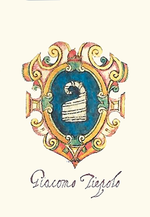
Jacopo Tiepolo
Encyclopedia


Venice
Venice is a city in northern Italy which is renowned for the beauty of its setting, its architecture and its artworks. It is the capital of the Veneto region...
; d. 19 July 1249, Venice) was Doge
Doge
Doge is a dialectal Italian word that descends from the Latin dux , meaning "leader", especially in a military context. The wife of a Doge is styled a Dogaressa....
of Venice from 6 March 1229 to 2 May 1249. Previously, served as a first Venetian duke of Crete and podestà
Podestà
Podestà is the name given to certain high officials in many Italian cities, since the later Middle Ages, mainly as Chief magistrate of a city state , but also as a local administrator, the representative of the Emperor.The term derives from the Latin word potestas, meaning power...
in Constantinople
Constantinople
Constantinople was the capital of the Roman, Eastern Roman, Byzantine, Latin, and Ottoman Empires. Throughout most of the Middle Ages, Constantinople was Europe's largest and wealthiest city.-Names:...
(1218-1220 and 1224-1227).
At the election for doge, Tiepolo and his rival Marino Dandolo were tied at 20 votes each, and Tiepolo was selected by drawing lots
Sortition
In politics, sortition is the selection of decision makers by lottery. The decision-makers are chosen as a random sample from a larger pool of candidates....
. This is thought to have sparked the feud between the Tiepolo, who were an old aristocratic family and the Dandolo, who were seen as a nouveau-riches. Prior to ascending the ducal throne, Tiepolo also had to sign a trational promissione, which seriously limited his powers.
Despite Frederick II Hohenstaufen's cordial visit in Venice in 1232, the relations between the emperor and the Republic deteriorated and, in 1239, Venice joined the Lombard League
Lombard League
The Lombard League was an alliance formed around 1167, which at its apex included most of the cities of northern Italy , including, among others, Crema, Cremona, Mantua, Piacenza, Bergamo, Brescia, Milan, Genoa, Bologna, Padua, Modena, Reggio Emilia, Treviso, Venice, Vercelli, Vicenza, Verona,...
and fought against Ezzelino III da Romano
Ezzelino III da Romano
Ezzelino III da Romano was an Italian feudal lord in the March of Treviso who was a close ally of the emperor Frederick II and ruled Verona, Vicenza and Padua for almost two decades...
, a powerful ally of Frederick. In the subsequent fights the Doge's son, Pietro Tiepolo, was captured at the battle of Cortenuova
Battle of Cortenuova
The Battle of Cortenuova was fought on 27 November 1237 in the course of the Guelphs and Ghibellines Wars: in it, Holy Roman Emperor Frederick II defeated the Second Lombard League.-Background:...
1237 and died in prison in South Italy.
Jacopo Tiepolo's reign brought other important events: In 1242 the Doge proclaimed Statuto, the codification of the Venetian civil law - work begun by Doge Enrico Dandolo
Enrico Dandolo
Enrico Dandolo — anglicised as Henry Dandolo and Latinized as Henricus Dandulus — was the 41st Doge of Venice from 1195 until his death...
. In the 1240s, two great mendicant orders: the Dominicans and the Franciscans, were granted land in the city and later built on it the two biggest churches in Venice, Santi Giovanni e Paolo
Santi Giovanni e Paolo
There are a number of churches in Italy named after the martyrs St. John and St. Paul , not the apostles, but two soldiers martyred for their faith in the years 361-363...
, (called San Zanipolo) and Basilica di Santa Maria Gloriosa dei Frari
Basilica di Santa Maria Gloriosa dei Frari
The Basilica di Santa Maria Gloriosa dei Frari, usually just called the Frari, is a church in Venice, northern Italy. One of the greatest churches in the city, it has the status of a minor basilica. It stands on the Campo dei Frari at the heart of the San Polo district...
.
In 1249 Tiepolo abdicated, retired to his own house and died after a few months. He was buried in the church of San Zanipolo.
Jacopo Tiepolo was the father of Lorenzo Tiepolo
Lorenzo Tiepolo
Lorenzo Tiepolo was Doge of Venice from 1268 until his death.Born in Venice, Lorenzo Tiepolo was the son of Doge Jacopo Tiepolo. It is a matter of debate if his second wife, Marguerite, was either the daughter of the King of Romania or of Bohemund of Brienne, ruler of Rascia...
who served as doge from 1268 to 1275 and the aforementioned Pietro Tiepolo, podestà of Padua
Padua
Padua is a city and comune in the Veneto, northern Italy. It is the capital of the province of Padua and the economic and communications hub of the area. Padua's population is 212,500 . The city is sometimes included, with Venice and Treviso, in the Padua-Treviso-Venice Metropolitan Area, having...
.

